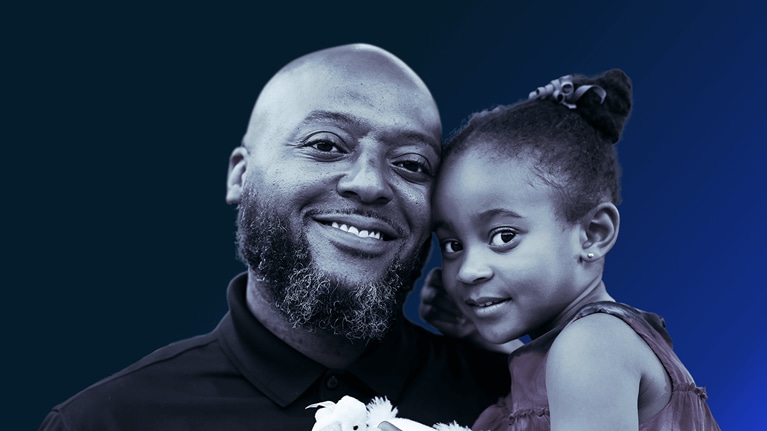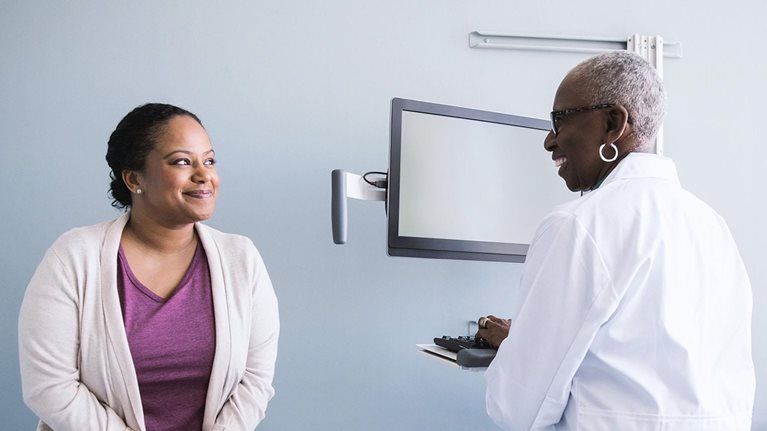Zip code can be as big a factor as genetic code when it comes to health.1 What will it take to change that?
It’s a question that drives Cheryl Pegus, MD, MPH, across her many roles in healthcare and business: as a cardiologist, public health expert, healthcare executive, and currently as managing director at Morgan Health Ventures, where she helps guide investments into innovative healthcare businesses. Throughout her impactful career, which includes serving as the executive vice president of health and wellness at Walmart, Dr. Pegus has focused on ways to improve healthcare for medically underserved communities.
“If we’re really focused on improving health equity, we actively prioritize bringing healthcare to those geographic areas. We don’t wait for something magical to happen,” Dr. Pegus told Melvin Mezue, a partner in McKinsey’s healthcare practice and a leader in the McKinsey Institute for Black Economic Mobility (BEM). Dr. Pegus and Dr. Mezue recently sat down for a special edition of the McKinsey Health Institute’s (MHI’s) Conversations on Health series to discuss issues of critical importance to BEM and MHI stakeholders, including health equity, the future of healthcare, and the value of diversity at the business table for successful innovation and investment.
The interview has been edited for clarity and length.
Melvin Mezue: In your career, you started as a clinician, practiced as a clinician, and now you spend most of your time on the other side of the fence—thinking about healthcare businesses and how you can support them. I would love to hear more about your path and what or who inspired you to pursue it.
Cheryl Pegus: Early on in my life, I had a sick grandfather. We grandchildren and others helped take care of him. As he got sicker, I realized that part of what was going on was that he couldn’t afford to go to the doctor. And when he did go to the doctor, he would feel like he wasn’t being treated well. I was about 12 years old, and I would take care of what I now know was probably a diabetic foot ulcer. My job was to dress and change the wounds in the evenings and on weekends.
I’ve managed my career and my choices with a look at what’s possible in healthcare and what I, specifically, can contribute to that. I became a cardiologist. But before going into cardiology, I got my master’s in public health. Broadening my expertise was necessary, whether it’s clinical trial design and recruitment by working at pharmaceutical companies or payment models by working at payers. And then innovating where there were gaps, to see where we could truly provide wonderful healthcare to people across the US.
I still have that same curiosity and interest in doing good work in healthcare. And I’m always pretty optimistic about what’s possible.
Melvin Mezue: That’s a very inspirational journey. What is something you gained from your time as a clinician that you apply as you take on these new roles?
Cheryl Pegus: People tend to be surprised that a clinician is interested in what some might call the “business” of medicine. Whereas I think, “Who else should be interested in those areas?”
When I am looking at companies or at solutions that are being developed from an entrepreneurial perspective, I’m always wondering, “Who is the clinician who’s going to implement this? Who is the clinician who’s going to champion this with their patient?” And when I ask an entrepreneur, “Who assisted you with the clinical build?” and there’s a blank stare, I wonder even more.
Melvin Mezue: That translatability from the clinical side to the business side is really critical. There are few people in a better position than natural clinicians who can understand and take advantage of some of the opportunities that exist right now in the space.
Cheryl Pegus: And what that means, Melvin, is that clinicians have to gain new skills.
You do not finish medical school, residency, and fellowship ready to run a hospital, a business, a telehealth company, or a payer company. It does require additional skills, additional partnerships. And that presents an exciting opportunity for young people to consider when entering the field of medicine.
The business case for health equity
Melvin Mezue: In terms of health equity, if we look at life expectancy, we know from our research at BEM that it is substantially worse for the Black population than it is for other populations in the country. About 3.3 million more Black Americans would be alive if there was parity in life expectancy.2 There are lots of factors that contribute to that. What do you think is ideal and what do you think is realistic, in terms of what levers can be pulled to make a difference?
Cheryl Pegus: I’m much more pragmatic than I am idealistic about the ways I look at healthcare and what’s doable.
Health equity gets defined in many different ways, but it’s really just everyone having a fair and just opportunity to attain the highest level of health. That’s really it. And that’s for everybody. There is poor health equity in rural America; there’s poor health equity in urban centers of America; there’s poor health equity globally. If we focused on that from a business lens, with an eye for financial sustainability of solutions, we could do a lot more in healthcare. That’s the first place I would start.
We know that zip code is more important than genetic code. People seek healthcare locally. If within a specific zip code there is poor access to healthcare, whoever lives there has bad healthcare. If we’re really focused on improving health equity, we bring healthcare to those areas. We don’t wait for something magical to happen.
Healthcare implementation does not need hundreds of physicians to improve outcomes. Instead, we need teams of people with complementary skill sets: a community health worker, a pharmacist, and a nurse practitioner. There is a lot of great care that people whom you trust to listen to you can provide. Those who can address your transportation needs or help in finding a doctor or cost-effective medications. The physician themself or nurse practitioner doesn’t need to do it all—teams matter in healthcare.
If we don’t start with people getting access to preventive care, early screening, and early treatment, then we could continue to end up with statistics like, “America has a $4.5 trillion cost of healthcare.”3
Melvin Mezue: It’s interesting that you ended on a cost piece. I’m often asked about the business case for health equity. Sometimes people will say, “Hey, we know it’s the right thing to do, but how do we actually get organizations to take this as seriously as other transformations or changes they want to make?” In your experience, how have you approached that question?
Cheryl Pegus: I always present a business case. If I’m in a particular region and I look at the population of the region and the spend on healthcare, I always say, “What’s the percentage of that spend that, if we intervened earlier, could actually be a business opportunity?”
If you’re able to have early preventive solutions or areas where you’re able to look at different criteria, be it immunizations or measurement of different diseases, and you’re able to manage them so you can prevent hospitalization, that is money you can earn and build a business on.
It’s the same as when you look at some of the social determinants, such as access to healthy food or transportation. The reason that a lot of entrepreneurial businesses enter this area is not just that they think it’s for the public good. There is a business case. Same thing for hybrid care, telehealth, and in-person care. In a lot of these communities, to be able to sustain the capital overhead of having a physical site requires you to have some telehealth and maybe in-home care as well. It’s also about building out that business model, looking at where payments come from, and then setting it up so that you can recruit not just investors but partners. Not only is it doable, but you and I are also aware of a number of companies that have been very successful at this.
Investment and innovation in healthcare
Melvin Mezue: What kind of role do you think venture investing or impact investing could have in a space like this? And how could it accelerate the impact?
Cheryl Pegus: The mindset of innovation is not something we’re really taught in healthcare. We’re taught safety and efficacy and how to make sure we do no harm. When you innovate, you take risks. And you need other people to sit at the table and say, “It’s OK to take that risk.”
If everybody’s the same around the table, research shows they keep doing the same thing. You’ve got to introduce new people into investing for that to change. We’re seeing that happen now, as an example, with women’s health. Now that we’ve seen more women in private equity, more women who are coming into their teams as principals, we’re seeing that change.
There’s still not a lot of money going toward women’s health, and women’s health innovators will tell you they still run up against some walls when they’re trying to gain access to funding for areas such as fertility or menopause. We know that this country has one of the highest maternal mortality rates among high-income countries. But that’s changing because the people at the table are changing. It’s really that simple. If you walk into a room and you’re talking about a topic that no one at the table knows or understands, they’re less likely to invest in it.
We’ve got to make sure that investors are broadening their teams as they look at new opportunities. We’ve also got to ensure that we’re presenting them as business cases. Just saying that this topic is a “public health issue” is not enough. We’re doing it to maintain a healthy business economy for healthcare.
Melvin Mezue: With many of the sweeping changes on the technology side—including AI, generative AI, and other innovations—there are certainly risks that we need to account for. How do you evaluate the potential risk and impact?
Cheryl Pegus: Healthcare has always utilized algorithms. For anyone whose doctor tells you, “Here’s your cardiovascular risk score,” or, “Here is your glomerular filtration rate,” that is from an algorithm. We take data from multiple populations, put it together, and build an algorithm. And when possible, it’s stratified by demographics. We also utilize algorithms, for example, in predictive modeling to determine how much diabetes costs if you’re early or late stage or to read EKGs [electrocardiograms]. This increased use of AI in many new forums and ways is what we need to explore.
Melvin Mezue: Some might say we haven’t always used AI responsibly.
Cheryl Pegus: That’s the real issue, right? Do we know how to use it well? People like you and many others have written on the fact that AI is sometimes utilized to determine how much to spend on a particular population of people. Unfortunately, what the algorithms have sometimes done depends on who’s sitting in the room and building that algorithm.
There is a responsibility to understand the data you collect, how you collect it, and how you’re going to use it. That speaks to having well-trained biostatisticians and epidemiologists who understand these issues in the room when you’re looking at the data.
Again, diversity of thought is necessary to come up with solutions that allow us to obtain better clinical outcomes.
There’s a generation of young healthcare professionals who’ve been raised on the internet and who utilize IT platforms, social media, et cetera. They should get engaged in healthcare AI development, as it is in its infancy. This is one area where having more people with a healthcare and clinical background involved makes for a huge asset. Businesses that focus on healthcare AI will be built, and the teams building them should be multidisciplinary: clinicians, epidemiologists, actuaries, and AI scientists and engineers. They will be taking on the responsibility of building solutions for better human health.


